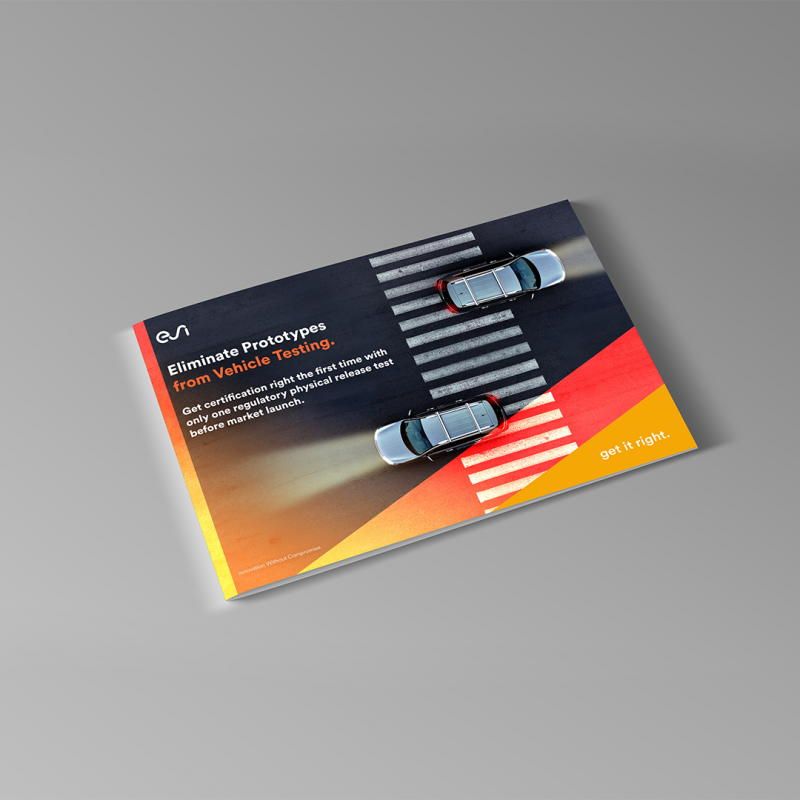Why Shift Towards Virtual Vehicle Homologation
Advancing Vehicle Safety Testing With Simulation of Realistic Crash Scenarios

In today's dynamic automotive landscape, emerging technologies continually prompt waves of regulations focused on enhancing both active and passive safety measures. For automakers and suppliers, compliance with these regulations is paramount, necessitating thorough verification and validation across diverse environments and scenarios. Moreover, the success of new business models hinges on OEMs delivering convincingly on their Vision ZERO commitments promptly. However, achieving these goals requires alleviating crash and safety engineers from the significant obstacles posed by the escalating complexity of vehicle variants and systems, enabling them to test an expanding array of use cases efficiently. While once predominant, physical testing now presents limitations in accommodating design changes in the early development stages, often resulting in time-consuming modifications and delays in finalizing product designs and launches.
Because of its enhanced accuracy, lifelike human body models, and the capability to digitally predict intricate scenarios, virtual testing of vehicle performance and virtual crash simulation is gaining traction in replacing physical crash testing for regulatory certification. Through such a fully digital virtual prototyping approach, automakers achieve vehicle certification for crash, safety, and reliability for the first time without endangering humans or our planet.
This blog article focuses on the benefits of combining crash simulation with system simulation software. Engineers use this co-simulation approach to virtually assess the influence of active safety systems on crash results. They explore multi-disciplinary system variations and study the relationship between active and passive safety systems. You'll find out why engineers are embracing this more economic alternative to extensive physical safety and crash testing and how co-simulation with the simulation tools VPS and SimulationX provides the most accurate results.
First, let's Clarify the Meaning: What is Product Homologation for Vehicles, Components and Systems?
Homologation in general refers to the process of certifying that a product, system, or process meets specific regulatory standards, requirements, or specifications. It involves demonstrating compliance with applicable regulations, safety standards, technical specifications, or performance criteria set by regulatory authorities or industry organizations. Homologation is commonly required in various industries such as automotive, aerospace, and others to ensure that products are safe, reliable, and meet quality standards before they can be marketed or used commercially.
Why do Automotive Manufacturers Need to Shift to Virtual Vehicle Homologation of Car Crash Testing?
In today's global automotive arena, crash safety certification stands as a paramount concern for automakers. With the convergence of computer simulation technologies and physical tests, the industry has witnessed significant advantages in attaining coveted certifications like the Global NCAP rating. As the automotive sector undergoes rapid transformation, and simulation technologies continue to evolve, crash engineers are redefining traditional vehicle crash test scenarios. While the standard front, side, and rear impact tests suffice for the necessary certification, they may not adequately address the emerging automotive trends such as electrification and autonomous driving. These trends highlight the growing dependence of modern systems on the precise prediction of crash impacts.
Let’s explore how Advanced Driver Assistance Systems (ADAS) necessitate a meticulous and accurate evaluation of pre-crash scenarios through virtual prototyping: The Anti-lock Braking System (ABS) is a commonplace feature in ADAS, designed to prevent wheel lock during emergency or heavy braking, thereby averting skidding and loss of control. In real crash situations, ABS can aid in timely stopping, but it may not constitute an ideal scenario. Instead, the focus is shifting towards a broader range of pre-crash scenarios, which consider changes in vehicle and occupant positions resulting from braking and steering maneuvers post-ABS activation.
Embracing this wider spectrum of crash scenarios becomes economically and practically feasible through virtual testing, necessitating a shift from the traditional homologation approach to a more realistic consideration of real-life crash scenarios.
Spotlight on a Special Application: How to Get Co-Simulation with VPS and SimulationX for Pre-crash Scenarios Right?
Crash and safety engineers first create a Finite Element (FE) model of a vehicle and subject it to side, rear, and front impacts, thus enhancing overall design and safety. The FE model suffices for standard testing, but to achieve a comprehensive view, system-level models are integrated, enabling the evaluation of control algorithms and mechatronic actuators' behavior in different scenarios, particularly related to ABS braking effects in pre-crash situations. Two key tools for this process are the Virtual Performance Solution (VPS), a FE-based crash and safety simulation software, and SimulationX, a Modelica-based multi-domain system modeling and simulation software.
SimulationX facilitates the construction of a detailed system-level ABS brake model, including control algorithms and hydraulic actuators. This model is then integrated into the FE structure model of the vehicle using the Functional Mock-up Interface (FMI), a pivotal component that directly influences vehicle safety. The utilized latest FMI 3.0 standard simplifies the data exchange in this integration process.
The ABS brake unit is comprehensively modeled within SimulationX, utilizing the Modelica-based Hydraulics and 1D-Mechanics libraries. An FMU (Functional Mock-up Unit) is automatically generated for this ABS brake unit. SimulationX offers full flexibility in selecting model variables as FMU inputs and outputs. Subsequently, the FMU is imported into the Virtual Performance Solution tool, employing special Modelica connectors developed by ESI Group. These connectors ensure precise mapping of the kinematic quantities between the ABS brake unit in the FE model of the vehicle. This approach ensures consistency in nodal data across computational domains and allows for multiple instances of an FMU in a simulation, enabling a separate ABS actor on each wheel.
Spotlight on Homologation Standards and Processes: Why is a Digital Test Track the More Economical and Precise Alternative to Extensive Physical Safety And Crash Testing?
Looking at existing certification procedures, the process of vehicle homologation is anything but sustainable in terms of time, natural ressources and emmisions that are needed for launching a new car on the market.
At ESI, we envision a future where a digital test track offers an alternative to extensive physical safety and crash testing. The co-simulation process boasts minimal chances of numerical errors, as the explicit VPS solver employs small step sizes, resulting in negligible time delays between inputs and outputs. Additionally, newer features such as the interpolation of FMU-input values with FMI 3.0 further reduce errors without significantly increasing computational costs.
Innovation in simulation technologies and the breaking down of barriers to facilitate interaction and integration between different software and tools exemplify ESI's approach to developing future solutions for next-generation products. This approach creates a comprehensive simulation ecosystem and interfaces that enable the thoughtful design and engineering of vehicles, complete with thorough testing for crash and impact scenarios, incorporating fully integrated ABS and similar systems. This level of control ensures that models are neither over-engineered nor under-engineered, resulting in substantial returns on investment.
Notably, this solution is designed to be accessible and transparent, eliminating the need for system engineers and experts to possess extensive FE modeling knowledge. This accessibility extends to FE experts using FMUs as well. Consequently, automotive OEMs and Tier-1 suppliers have reaped substantial benefits from these innovative technologies, enabling them to maintain a competitive edge, reduce costs, meet industry certifications, and introduce exceptional products to the market at the right time. The ongoing exploration of extending this methodology to integrate control algorithms in FE models for various crash scenarios demonstrates a commitment to continuous innovation and improvement in the field of automotive safety. These potential extensions could involve areas such as airbag activation, seatbelt tensioners, modeling of human bodies with active muscles, and the replacement of flexible FE bodies with rigid multi-body system models to reduce computation time, among others.
Dive Deeper into How to Achieve "right the first time" Homologated Cars While Eliminating Physical Prototypes from Vehicle Crash & Safety Testing

Download this eBook to discover how to realize safe, clean, and efficient development and achieve certification with only 1 regulatory test before market launch.
With several years of experience in cross-functional roles in the web & information technology domains, Majid spent most of his formative years embracing technological advancements & digital solutions. At ESI, he is currently leading the go-to-market and sales enablement function for system simulation solutions with significant contributions to the global marketing, technical marketing & industry marketing teams along the way. He possesses the right blend of a techno-business approach rooted in his academic background in computer science & business communications.